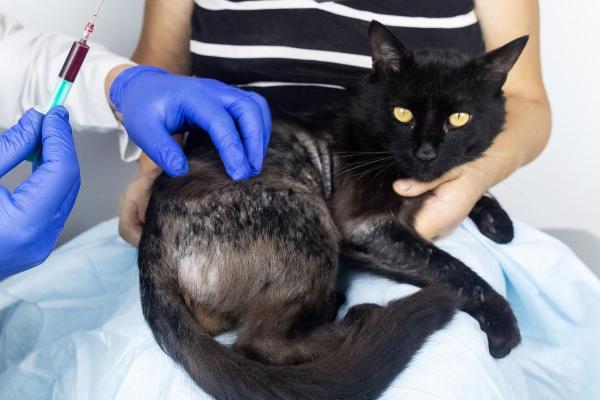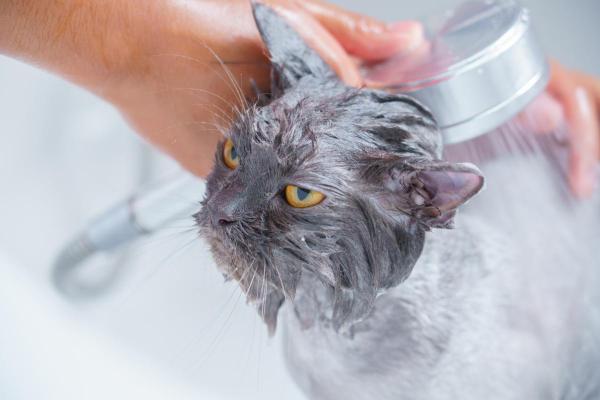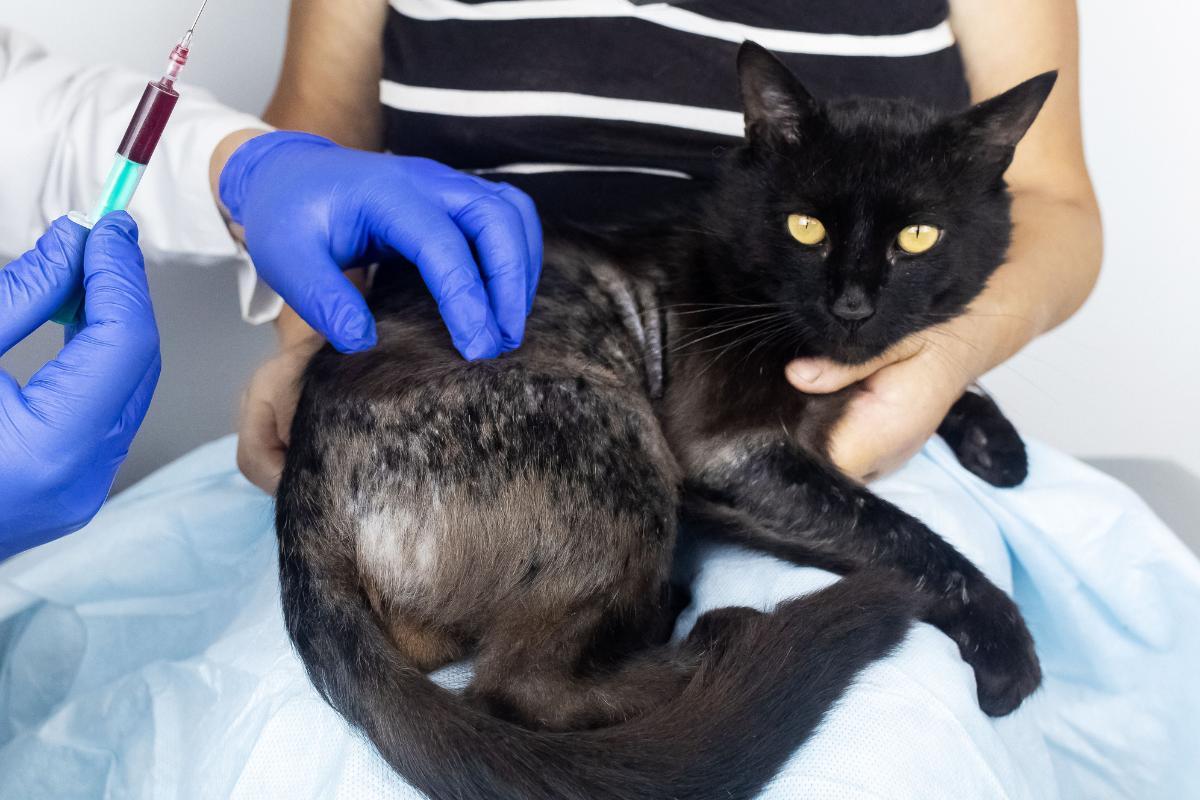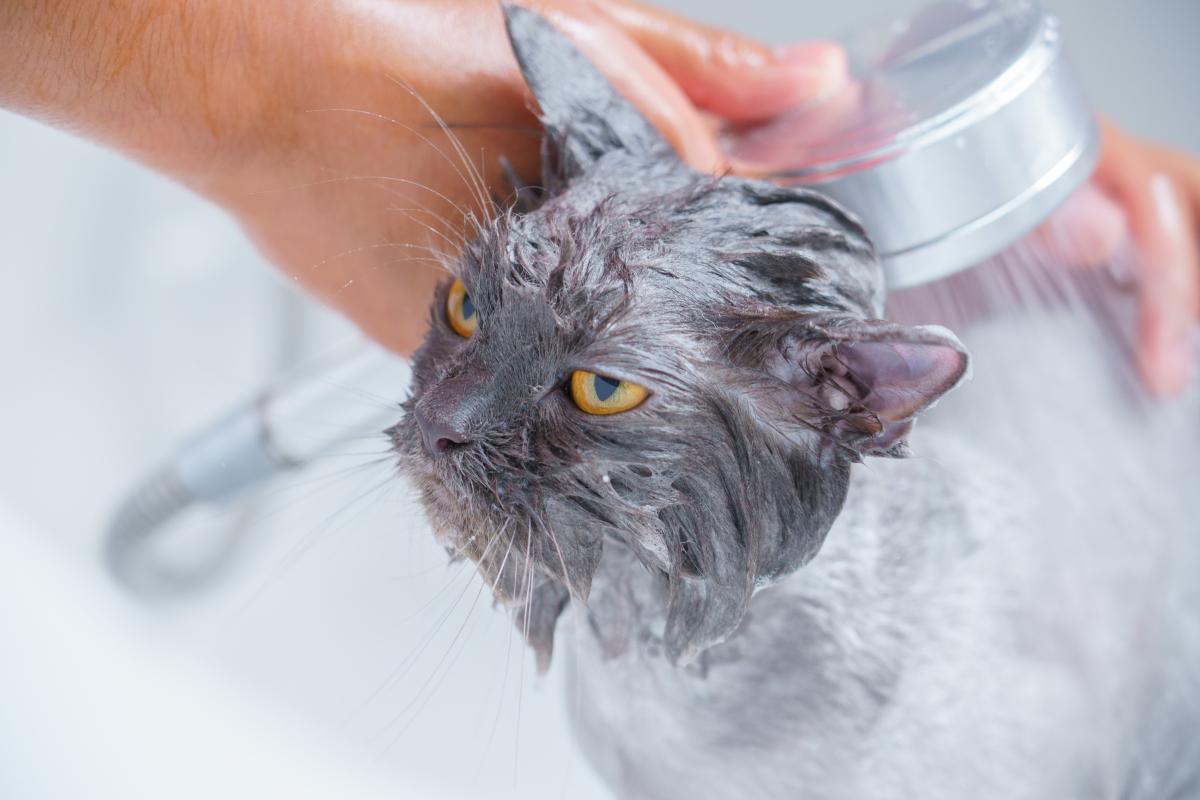How to Treat Dermititis in Cats



See files for Cats
Dermatitis in cats is a common and troublesome skin condition marked by inflammation, itching, and often hair loss. This condition can stem from various factors, including environmental allergens, food sensitivities, parasitic infestations, bacterial or fungal infections, hormonal imbalances, and autoimmune disorders. Accurate diagnosis is essential for effective treatment, as identifying the specific type of dermatitis allows veterinarians to create targeted treatment plans that address the root cause and alleviate symptoms.
In this AnimalWised article, we delve into the treatment options for feline dermatitis, exploring its various forms, symptoms, and effective home remedies to help manage and alleviate this common condition.
What is dermatitis in cats?
Dermatitis in cats is an inflammatory skin condition that leads to irritation and discomfort.
It can be triggered by different factors like environmental allergens (atopic dermatitis), parasites, or food hypersensitivity. Although the underlying causes may differ, symptoms often overlap, with common signs including scabs, rashes, and skin lesions.
Cats with dermatitis frequently experience intense itching, which leads to excessive scratching, worsening the lesions and causing hair loss, bleeding, and secondary infections. This condition can significantly affect a cat’s well-being, often resulting in behavioral changes like increased aggression or heightened anxiety due to the constant discomfort.
Types of dermatitis in cats
Dermatitis in cats can manifest in various forms, depending on the underlying cause. These skin issues can be broadly categorized into three main types: allergic, infectious, and parasitic dermatitis. Additionally, hormonal imbalances, autoimmune disorders, contact dermatitis, seborrheic dermatitis, and miliary dermatitis may also trigger skin inflammation. Here is a more detailed view:
Allergic dermatitis
Allergic dermatitis is a common skin condition caused by an overreaction of the immune system to environmental allergens, food, or parasites. The most frequent types include:
- Atopic dermatitis: triggered by environmental allergens like dust mites, pollen, or mold.
- Food hypersensitivity dermatitis: caused by adverse reactions to certain dietary components.
- Flea allergy dermatitis (FAD): resulting from an exaggerated immune response to flea saliva.
Infectious dermatitis
Infectious dermatitis arises from bacterial or fungal infections, such as:
- Bacterial dermatitis (pyoderma): often secondary to conditions like allergies.
- Fungal dermatitis (ringworm): caused by a fungal infection.
Parasitic dermatitis
Parasitic dermatitis is a skin condition caused by infestations of external parasites, such as fleas, ticks, or mites. These parasites can irritate the cat's skin, causing itching, redness, and hair loss.
Beyond these categories, other forms of dermatitis include:
- Hormonal dermatitis, associated with disorders like hyperthyroidism or Cushing’s disease.
- Autoimmune dermatitis, where the cat's immune system mistakenly attacks its own skin.
- Contact dermatitis, caused by direct exposure to irritants or allergens.
- Seborrheic dermatitis, due to abnormal sebum production leading to flaky or greasy skin.
- Miliary dermatitis, recognized by small, crusty scabs, often triggered by allergies or infections.
Curious about other skin conditions in cats? Discover how to identify and manage another form of dermatitis here.

Symptoms of dermatitis in cats
As mentioned earlier, feline dermatitis is an inflammatory skin condition that can be triggered by various underlying factors.
Despite the different causes, dermatitis in cats tends to present with similar clinical symptoms. Recognizing these signs early is essential for prompt treatment and improved outcomes. these common symptoms include:
- Intense itching (pruritus): cats often display persistent scratching or biting at affected areas.
- Excessive licking: cats may excessively groom themselves, particularly in the areas that are most irritated.
- Frequent scratching: this can further exacerbate skin damage, leading to secondary infections.
- Self-mutilation: in severe cases, the constant scratching and licking can result in open wounds or sores.
- Skin irritation and redness: inflammation causes the skin to appear red and swollen.
- Swelling or bumps on the skin: localized swelling or lumps may appear due to inflammation or infection.
- Thickening of the skin: chronic dermatitis can lead to the skin becoming rougher and thicker over time.
- Alopecia (hair loss): hair loss in affected areas is common, often in patches.
- Skin rashes or abrasions: visible signs of skin damage can include small rashes or raw spots from constant scratching.
- Miliary dermatitis: this is characterized by numerous small, red, crusty bumps (papules), usually caused by allergic reactions or parasites.
Curious about other skin conditions that might affect your cat? Learn how to keep your cat’s skin safe from sunlight in our next article.

Is cat dermatitis contagious?
Dermatitis in cats is generally not contagious, as it typically results from an internal reaction to environmental allergens, parasites, or food sensitivities.
The condition itself does not spread between cats because it is not caused by contagious bacteria or fungi. However, it’s important to note that certain underlying causes of dermatitis, such as flea infestations, can be spread among cats.
Flea allergy dermatitis (FAD) is an example where the condition itself isn't contagious, but the fleas that trigger the reaction can be passed from one cat to another. Thus, maintaining regular antiparasitic treatments is essential to prevent flea transmission, which could lead to dermatitis in sensitive cats.
It's also important to recognize that not all cats will develop dermatitis from flea bites or other allergens, as each cat's immune system responds differently. This variability is why dermatitis cannot be considered contagious; it depends on an individual cat's sensitivity and immune response.
For a deeper understanding of the critters that could be causing skin problems in your cat, explore our guide on identifying and managing different types of parasites.
Diagnosing dermatitis in cats
If we notice skin lesions in our cat accompanied by frequent scratching, we may suspect dermatitis. However, only a veterinarian can accurately diagnose feline dermatitis and determine its type. The process typically begins with a thorough physical examination and a detailed history taken from the cat’s caregiver.
Depending on the suspected cause, the veterinarian may recommend one or more of the following tests:
- Skin Scrapings: to examine for parasites like mites.
- Fungal cultures: to identify fungal infections like ringworm.
- Blood tests: to rule out underlying medical conditions or allergies.
- Allergy testing: to identify specific allergens that may be causing atopic dermatitis.
- Biopsy: a small sample of skin may be taken for microscopic examination to identify the underlying cause of the dermatitis.
In cases where food hypersensitivity dermatitis is suspected, an elimination diet is often recommended. This involves feeding the cat a hydrolyzed or novel protein diet for 8 to 12 weeks. If the symptoms resolve during this period and return once the previous food is reintroduced, food-related dermatitis is confirmed.
Treatment for dermatitis in cats
The primary goal in treating feline dermatitis is to eliminate the underlying cause, whether it's allergens, irritants, or parasites. The specific treatment approach will vary depending on the type of dermatitis.
Food dermatitis
For cats with food dermatitis, identifying and avoiding the offending allergen is crucial. This often involves an elimination diet trial, where the cat is fed a novel protein diet to determine if their symptoms improve.
Atopic dermatitis
Managing atopic dermatitis involves reducing exposure to environmental allergens like pollen and dust mites. This can be challenging, especially during allergy seasons. Strategies may include:
- Using air purifiers, frequent cleaning, and avoiding exposure to secondhand smoke.
- Limiting outdoor time during peak allergy seasons.
- Providing a clean and allergen-free space for the cat to rest.
Flea allergy dermatitis
Preventing and treating flea infestations is essential for managing flea allergy dermatitis. This involves:
- Using effective flea medications as recommended by your veterinarian.
- Treating the cat's living space to eliminate fleas and their eggs.
- Ensuring the cat is free of intestinal parasites, which can contribute to flea infestations.
Beyond addressing the root cause, treatment for dermatitis often involves a combination of medications, topical treatments, and dietary supplements. Anti-inflammatory drugs can help reduce inflammation and swelling, while antihistamines can alleviate itching. To prevent or treat secondary infections, antibiotics may be prescribed. Additionally, medicated shampoos or ointments can soothe the skin and reduce itching. Dietary supplements containing fatty acids can help improve skin health and reduce inflammation.
The most effective treatment plan will be tailored to your cat's specific needs and the underlying cause of the dermatitis. Consulting with a veterinarian is essential for a proper diagnosis and treatment recommendation.

Home remedies for dermatitis in cats
Home remedies for dermatitis in cats can be used to complement veterinary treatment, but it’s essential to consult with a vet first to ensure your cat's safety. Here are a few remedies that may help soothe mild dermatitis:
- Oatmeal baths: Oatmeal has natural anti-inflammatory properties and can soothe irritated skin. You can grind plain oatmeal into a fine powder and mix it with water to create a paste, or you can add it to a lukewarm bath for your cat. Gently applying this can help reduce itching and discomfort.
- Coconut oil: coconut oil has moisturizing and anti-inflammatory properties. Applying a small amount to affected areas can help relieve dryness and irritation. It’s also safe if the cat licks it off, but moderation is key.
- Aloe vera gel: aloe vera gel (free of additives or chemicals) can be applied to soothe irritated skin. It has healing and cooling properties, but make sure it is free from harmful components like aloin, as some forms of aloe can be toxic to cats.
- Chamomile tea: chamomile tea can be used to create a mild rinse for irritated skin. Brew the tea, let it cool completely, and gently apply it to the affected area with a cotton ball to reduce itching and inflammation.
- Apple cider vinegar: apple cider vinegar can be diluted with water (1 part vinegar to 3 parts water) and gently applied to hot spots or dermatitis-prone areas. It has antibacterial and antifungal properties but should not be applied to open wounds.
- Omega-3 fatty acid supplements: while not a direct topical treatment, omega-3 fatty acids (found in fish oil) help reduce inflammation and improve skin health when added to your cat’s diet. This can help manage chronic skin conditions like dermatitis over time.
Finally, regular cleaning of your cat’s bedding and living area reduces exposure to dust mites, fleas, and other allergens that could trigger dermatitis.
While these home remedies may provide temporary relief, they are not a substitute for professional veterinary care. It's crucial to identify and address the root cause of dermatitis, whether it’s allergies, parasites, or something else.
Curious about how to keep your feline friend fresh and clean without the need for bathing? Explore our practical guide on alternative grooming techniques.

This article is purely informative. AnimalWised does not have the authority to prescribe any veterinary treatment or create a diagnosis. We invite you to take your pet to the veterinarian if they are suffering from any condition or pain.
If you want to read similar articles to How to Treat Dermititis in Cats, we recommend you visit our Skin problems category.









